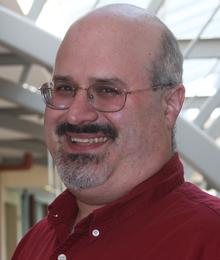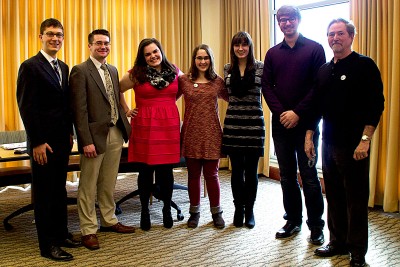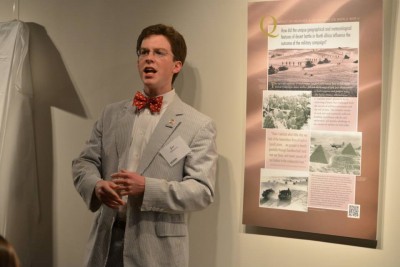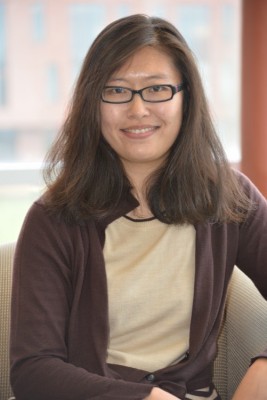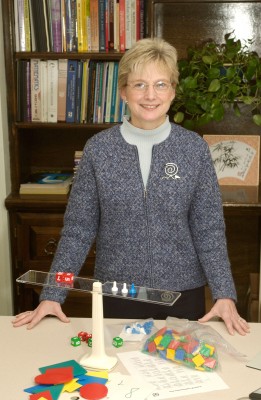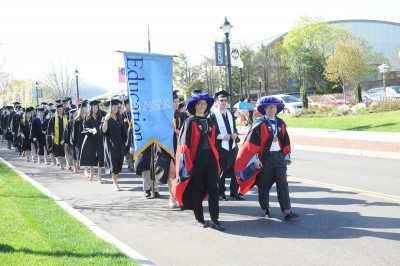 The Neag School of Education recognized graduates from the Class of 2014 during two ceremonies the weekend of May 10-11. The Neag School undergraduate commencement took place at the Jorgensen Auditorium on Sunday, May 11. Commencement for Neag School graduate students, including sixth-year students, took place Saturday, May 10, at Gampel Pavilion.
The Neag School of Education recognized graduates from the Class of 2014 during two ceremonies the weekend of May 10-11. The Neag School undergraduate commencement took place at the Jorgensen Auditorium on Sunday, May 11. Commencement for Neag School graduate students, including sixth-year students, took place Saturday, May 10, at Gampel Pavilion.
The Graduate School commencement speaker was Liza Donnelly, political and cultural cartoonist best known for her work with The New Yorker for the past 39 years. In addition, her images have appeared in numerous other national publications, includingThe New York Times, The Harvard Business Review, The Nation, Audubon, Glamour, andGood Housekeeping.
The author of 15 books, Donnelly is a celebrated and highly sought-after speaker and artist. Donnelly has also curated numerous exhibitions, among them an exhibition of cartoons about women’s rights at the annual conference of Women Deliver.
 The Neag undergraduate ceremony featured founder and executive director of Classes 4 Classes and Neag alumnus, Kaitlin Roig-DeBellis. Roig-DeBellis was the first grade teacher at Sandy Hook Elementary who saved the lives of 15 young students through her heroism and courage.
The Neag undergraduate ceremony featured founder and executive director of Classes 4 Classes and Neag alumnus, Kaitlin Roig-DeBellis. Roig-DeBellis was the first grade teacher at Sandy Hook Elementary who saved the lives of 15 young students through her heroism and courage.
In her commencement address, she talked about recently speaking to college students across the U.S., which got her thinking, “What would I say to my former student self? OR more importantly, what would I have wanted someone to say to me?”
She congratulated the new graduates, who were starting out on their own personal journey, but that “they alone will choose the course for their lives.”
Roig-DeBellis reflected on her personal story, one of an educator, “Even before college and high school, I knew my purpose was to become a teacher, and that guided me in every choice and decision I made.”
“We know that when we are passionate about anything, it guides us in every decision and choice we make,” she continued. “For myself, that passion has always been working with children.”
She talked about her life-long passion to pursue teaching, and how happy she was teaching and beginning her seventh year teaching, which was her sixth year at Sandy Hook Elementary. “I had just gotten engaged over the summer and life and its possibilities seemed truly endless. I now felt very settled and confident in my teaching. The year was passing rapidly, filled with much excitement and anticipation.”
“On December 14, everything came to a screeching halt,” she explained to an audience captivated by her story. “The fragility of life was brought to the forefront in an instant. Life changed in mere minutes.”
“What began as a beautiful, peaceful, calm day, was forever changed,” she continued.
She thoughtfully described each second up to and including the tragedy, including how she kept the bathroom door locked until a policeman proved his identity by sliding his badge under the door. She didn’t want to risk opening the door to the wrong person. The policemen then unlocked the door, and 15 frightened first-graders and one brave teacher were greeted by a swat team.
“I will never know who was more surprised by the site they saw, us, or them,” she continued. “I can only imagine they believed they were rescuing one small child, not an entire class.”
After experiencing the tragedy, instead of living her life with such profound meaning, she is now left searching for it.
“Something that grew out of that day — that the world, not just our nation, but the world was sending things to our school and to my class specifically and my kids had everything — teddy bears, cupcakes,” she said. “And I said, ‘I need to take this time to teach my students that when you get, you have to give.’ Because that’s what ultimately makes our world a better place.”
As an outcome of her experience, the first grade teacher decided to create a human lesson. She started a new organization to give back to the community, a website called Classes 4 Classes. The goal of the organization is to teach children in America to have a genuine interest in the well-being of others, by providing a platform through which to actively engage them in social curriculum. By allowing students to choose whom they want to help and how, Classes 4 Classes gives nearly every class the opportunity to help others, according to the website.
She continued the commencement speech with a quote from Mahatma Gandhi, “You must be the change you wish to see in our world.” Trust me when I say, that YOU can make all the difference in our world! What better day is there than today to start?”
She concluded with sharing that it was an honor and she was truly grateful to share her story. “Your lives commence right now. From the bottom of my heart, I say to you: always know your own purpose, choose to have a positive perspective, overcome your hard times and choose hope, you can BE the change in our world,” Roig-DeBellis ended.
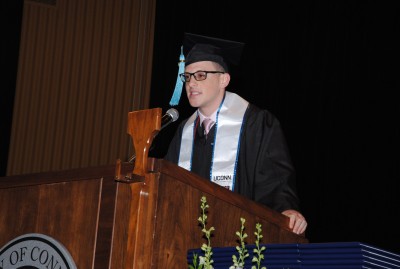 Prior to Rog-DeBellis’ speech, but before the close to 175 graduates received their diplomas, the platform party was introduced, and the Neag Alumni Society president offered a welcome. In addition, for the first time, a student speaker provided remarks.
Prior to Rog-DeBellis’ speech, but before the close to 175 graduates received their diplomas, the platform party was introduced, and the Neag Alumni Society president offered a welcome. In addition, for the first time, a student speaker provided remarks.
Justis Lopez, who is studying to be a secondary history teacher, was selected through a committee to provide remarks.
Lopez began by welcoming honored guests and recognizing all the mothers on Mother’s Day, including his own proud mother.
“Our years at UConn can be likened to the seasons of life,” he reflected over his four years at UConn. “Each year brought about a change of new beginnings, as we transitioned from youth into young adults.
Lopez continued on to thank those who supported him along the way, “There are many things that we do not have control over in our lives, much of our past has been shaped by the hands of individuals who are here in this room supporting us today, and I would like to thank every one of them.”
The student teaching experience was a “beautiful struggle” for him and he poured his everything into that classroom and into those students, whom he will truly miss seeing everyday.
He finished by offering insights to his fellow graduates, “Be a person that enters into someone’s life for a reason, to help them better understand the seasons.”
“And as we graduate to begin a new, I wish the same to all of you,” he concluded.
In addition to the student remarks, faculty member and University Teaching Fellow Dr. Jaci VanHeest was recognized with university-wide honors.
VanHeest is a UConn Teaching Fellow who, this year, was recognized by her students as an outstanding educator within the First Year Experience program. According to those whom she teaches, she is one of those inspiring role models that live every day to improve the lives of others. They highlight her level of dedication, determination, and concern that she has for all her students, she cheers those that are down, plans effective activities for learning, and finds time to let her students talk about their issues.
Her scholarship has been recognized by her other awards, but this one, nominated from the students themselves, focuses on the one major thing that our undergraduates expect. A dedication to achieve their success and growth. In that she wins hands down.
Dr. Mary Truxaw, another Neag faculty member who received university-wide honors, was recognized with a University Teaching Fellow award.
Truxaw’s teaching responsibilities include courses at both undergraduate and graduate levels and focuses predominantly on teacher education with an emphasis on mathematics education. In her teaching philosophy she states that “she is committed to instruction that challenges students while being sensitive to different learning needs and styles, as well as to cultural and linguistic diversity.”
Her departmental head comments that Truxaw’s accomplishments reflect her sincere commitment to excellence in teaching and research. She is a superb university instructor who consistently receives outstanding ratings from her students. One of whom writes “having her as a professor was truly an enjoyable experience. Her obvious passion and excitement for teaching made learning that much more exciting.”
Truxaw maintains a current research-based perspective of math education and instruction and her research findings appear in highly respected journals. She is a scholar of national importance in mathematics education and is held in high esteem by her peers.
Dr. Scott Brown was also recognized at Neag’s Commencement, by receiving the Board of Trustees Distinguished Professor award.
The Board of Trustees Distinguished Professor is the highest honor that the University bestows on faculty who have demonstrated excellence in teaching, research and service. Dr. Scott Brown is a professor of educational psychology and co-director of the GlobalEd 2 project, which has provided web-based STEM simulations to more than 3,000 middle school students.
He is recognized as an expert in learning and cognitive processing, specifically in the area of problem-based learning. His work in this area has addressed issues in Lyme disease education, scientific literacy in deaf and hearing impaired students, and promoting STEM education in students through international negotiations on the web through the GlobalEd 2 project.
His research has resulted in more than 120 scientific papers, book chapters, abstracts, and proceedings, in addition to two books, a monograph, and more than 250 conference presentations and addresses to professional groups. The Centers for Disease Control and Prevention, the National Science Foundation, and the U.S. Department of Education have funded his work for more than $12 million during his career at UConn.
Dr. Brown’s previous awards include the 2008 Outstanding Research Award from the Neag School of Education, the 2006 UConn Public Service and Engagement Program Award for the GlobalEd program, and the 2006 Thomas F. Donlon Award for Distinguished Mentoring from the Northeastern Educational Research Association.
A former head of the educational psychology department, he has also served as director of the Teachers for a New Era project and director of the Bureau of Educational Research and Service. He is also a Fellow of the American Educational Research Association and the Association for Psychological Science.
After both ceremonies, graduates, family and friends were treated to receptions at the Gentry Building, offering a time for celebration and reflection.
To view slideshows from both days, visit our Facebook page at http://www.facebook.com/neagschool.
 The Neag School of Education is offering a new online opportunity: Online Graduate Certificate in Leadership and Diversity Management in Sport. Professionals working in sports organizations and intercollegiate or interscholastic athletic administration can take their career to the next level with this innovative new program. The curriculum is comprised of four three-credit courses, which are offered during the summer semesters. Students can complete the certificate taking two classes over two summer terms, or take individual courses at their own pace.
The Neag School of Education is offering a new online opportunity: Online Graduate Certificate in Leadership and Diversity Management in Sport. Professionals working in sports organizations and intercollegiate or interscholastic athletic administration can take their career to the next level with this innovative new program. The curriculum is comprised of four three-credit courses, which are offered during the summer semesters. Students can complete the certificate taking two classes over two summer terms, or take individual courses at their own pace.
